Criminal Justice 10: Prison Reform from Historical to Modern Systems
VerifiedAdded on 2022/08/22
|12
|3245
|18
Essay
AI Summary
This essay provides a comprehensive overview of prison reform, tracing its historical development and examining modern-day systems. It begins by exploring the origins of prison reform, discussing the shift from corporal and capital punishment to incarceration as a more humane approach. The paper then delves into the historical context, focusing on the writings of Alexis De Tocqueville and Gustave De Beaumont, who analyzed the penitentiary systems of the United States and France. The essay highlights key figures like Zebulon Brockway, who advocated for prisoner rehabilitation and productive labor. It further examines the evolution of prison systems, the role of correctional facilities, and the importance of reform in safeguarding social reintegration. The discussion includes the different security classifications in modern prisons and the UN's benchmarks for prison reform. The essay emphasizes the need for integrated, multi-disciplinary strategies that address the needs of vulnerable groups and support the effectiveness of criminal justice policies. The paper also discusses the correctional services in France and the need for continuous improvement in prison conditions and penal systems.
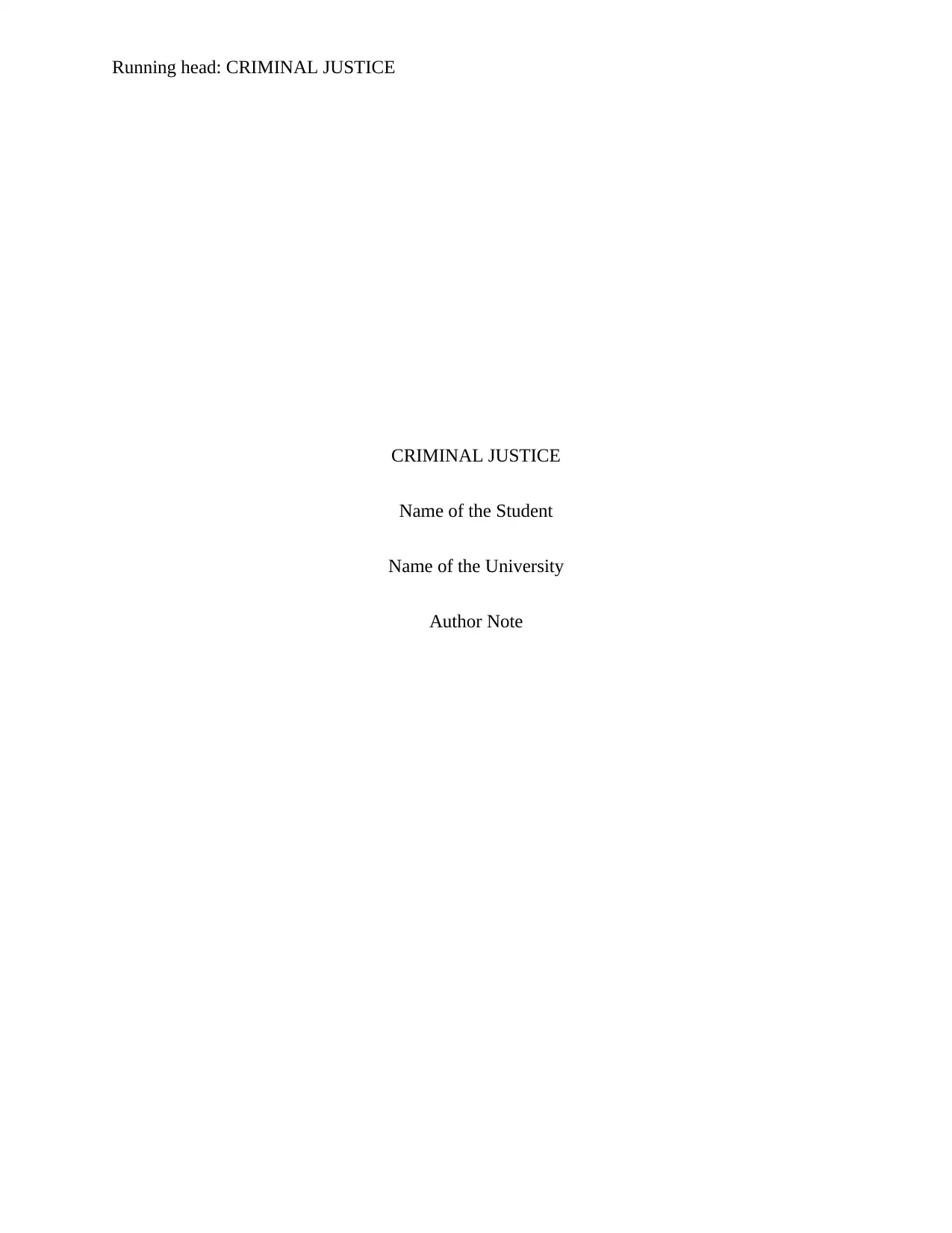
Running head: CRIMINAL JUSTICE
CRIMINAL JUSTICE
Name of the Student
Name of the University
Author Note
CRIMINAL JUSTICE
Name of the Student
Name of the University
Author Note
Paraphrase This Document
Need a fresh take? Get an instant paraphrase of this document with our AI Paraphraser
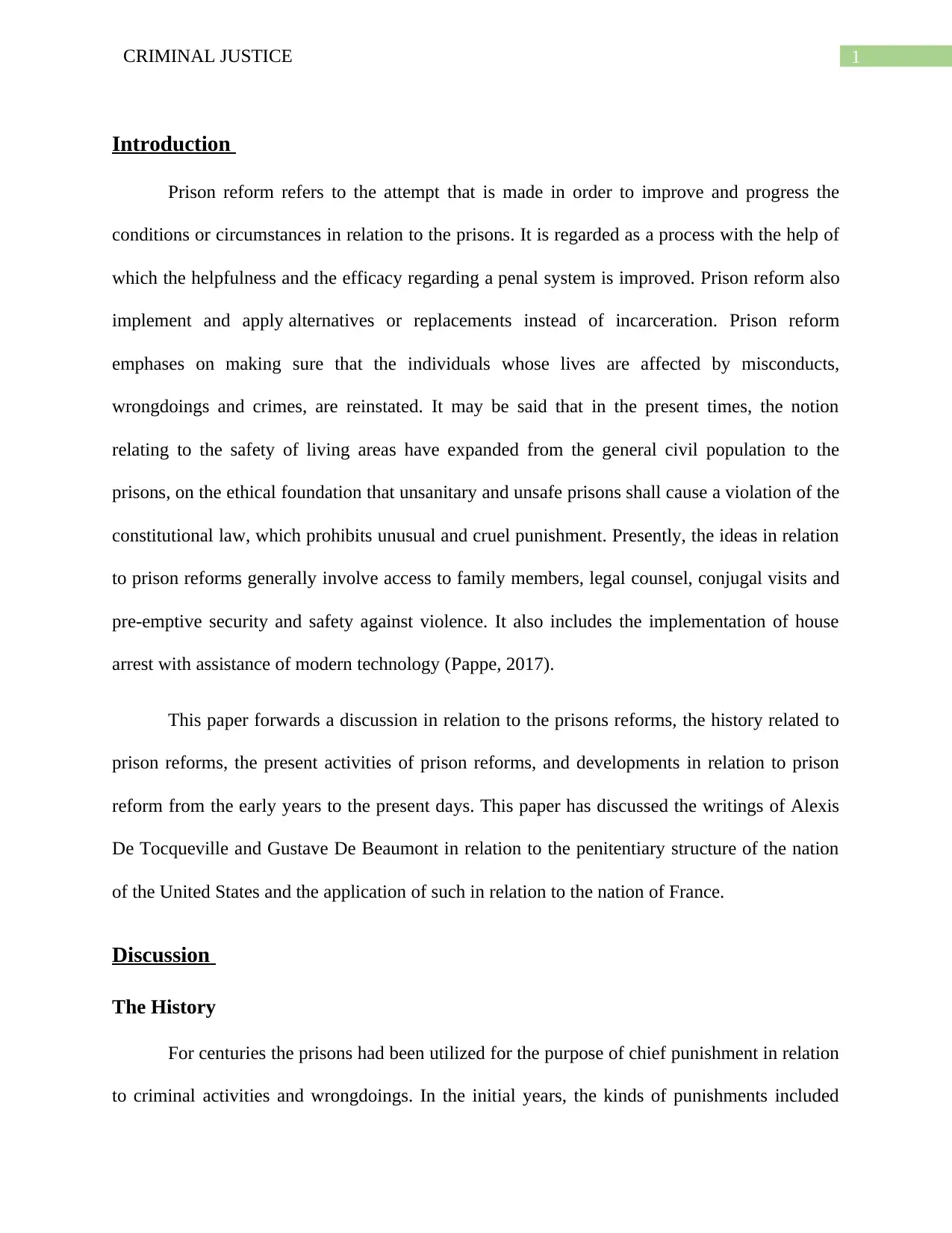
1CRIMINAL JUSTICE
Introduction
Prison reform refers to the attempt that is made in order to improve and progress the
conditions or circumstances in relation to the prisons. It is regarded as a process with the help of
which the helpfulness and the efficacy regarding a penal system is improved. Prison reform also
implement and apply alternatives or replacements instead of incarceration. Prison reform
emphases on making sure that the individuals whose lives are affected by misconducts,
wrongdoings and crimes, are reinstated. It may be said that in the present times, the notion
relating to the safety of living areas have expanded from the general civil population to the
prisons, on the ethical foundation that unsanitary and unsafe prisons shall cause a violation of the
constitutional law, which prohibits unusual and cruel punishment. Presently, the ideas in relation
to prison reforms generally involve access to family members, legal counsel, conjugal visits and
pre-emptive security and safety against violence. It also includes the implementation of house
arrest with assistance of modern technology (Pappe, 2017).
This paper forwards a discussion in relation to the prisons reforms, the history related to
prison reforms, the present activities of prison reforms, and developments in relation to prison
reform from the early years to the present days. This paper has discussed the writings of Alexis
De Tocqueville and Gustave De Beaumont in relation to the penitentiary structure of the nation
of the United States and the application of such in relation to the nation of France.
Discussion
The History
For centuries the prisons had been utilized for the purpose of chief punishment in relation
to criminal activities and wrongdoings. In the initial years, the kinds of punishments included
Introduction
Prison reform refers to the attempt that is made in order to improve and progress the
conditions or circumstances in relation to the prisons. It is regarded as a process with the help of
which the helpfulness and the efficacy regarding a penal system is improved. Prison reform also
implement and apply alternatives or replacements instead of incarceration. Prison reform
emphases on making sure that the individuals whose lives are affected by misconducts,
wrongdoings and crimes, are reinstated. It may be said that in the present times, the notion
relating to the safety of living areas have expanded from the general civil population to the
prisons, on the ethical foundation that unsanitary and unsafe prisons shall cause a violation of the
constitutional law, which prohibits unusual and cruel punishment. Presently, the ideas in relation
to prison reforms generally involve access to family members, legal counsel, conjugal visits and
pre-emptive security and safety against violence. It also includes the implementation of house
arrest with assistance of modern technology (Pappe, 2017).
This paper forwards a discussion in relation to the prisons reforms, the history related to
prison reforms, the present activities of prison reforms, and developments in relation to prison
reform from the early years to the present days. This paper has discussed the writings of Alexis
De Tocqueville and Gustave De Beaumont in relation to the penitentiary structure of the nation
of the United States and the application of such in relation to the nation of France.
Discussion
The History
For centuries the prisons had been utilized for the purpose of chief punishment in relation
to criminal activities and wrongdoings. In the initial years, the kinds of punishments included
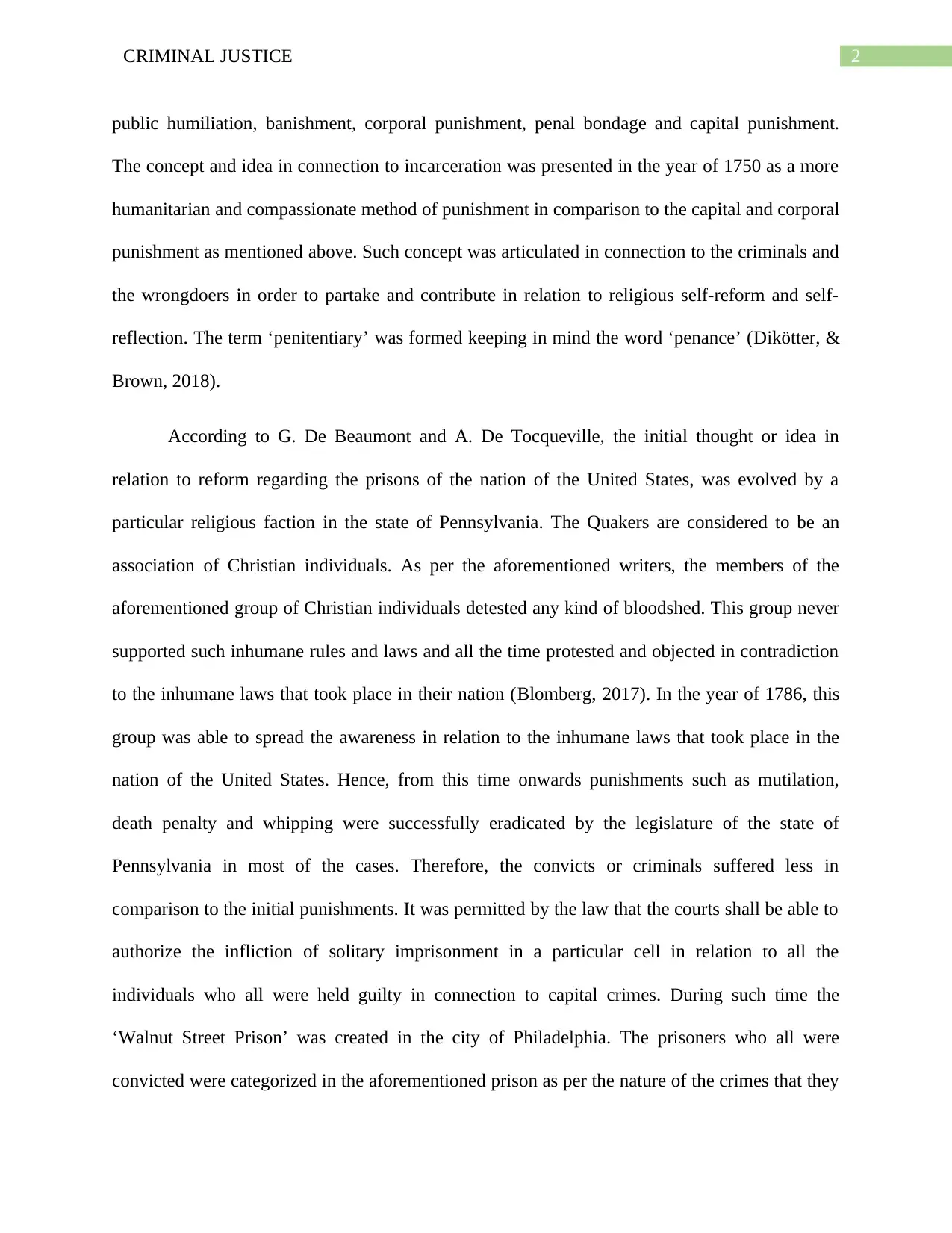
2CRIMINAL JUSTICE
public humiliation, banishment, corporal punishment, penal bondage and capital punishment.
The concept and idea in connection to incarceration was presented in the year of 1750 as a more
humanitarian and compassionate method of punishment in comparison to the capital and corporal
punishment as mentioned above. Such concept was articulated in connection to the criminals and
the wrongdoers in order to partake and contribute in relation to religious self-reform and self-
reflection. The term ‘penitentiary’ was formed keeping in mind the word ‘penance’ (Dikötter, &
Brown, 2018).
According to G. De Beaumont and A. De Tocqueville, the initial thought or idea in
relation to reform regarding the prisons of the nation of the United States, was evolved by a
particular religious faction in the state of Pennsylvania. The Quakers are considered to be an
association of Christian individuals. As per the aforementioned writers, the members of the
aforementioned group of Christian individuals detested any kind of bloodshed. This group never
supported such inhumane rules and laws and all the time protested and objected in contradiction
to the inhumane laws that took place in their nation (Blomberg, 2017). In the year of 1786, this
group was able to spread the awareness in relation to the inhumane laws that took place in the
nation of the United States. Hence, from this time onwards punishments such as mutilation,
death penalty and whipping were successfully eradicated by the legislature of the state of
Pennsylvania in most of the cases. Therefore, the convicts or criminals suffered less in
comparison to the initial punishments. It was permitted by the law that the courts shall be able to
authorize the infliction of solitary imprisonment in a particular cell in relation to all the
individuals who all were held guilty in connection to capital crimes. During such time the
‘Walnut Street Prison’ was created in the city of Philadelphia. The prisoners who all were
convicted were categorized in the aforementioned prison as per the nature of the crimes that they
public humiliation, banishment, corporal punishment, penal bondage and capital punishment.
The concept and idea in connection to incarceration was presented in the year of 1750 as a more
humanitarian and compassionate method of punishment in comparison to the capital and corporal
punishment as mentioned above. Such concept was articulated in connection to the criminals and
the wrongdoers in order to partake and contribute in relation to religious self-reform and self-
reflection. The term ‘penitentiary’ was formed keeping in mind the word ‘penance’ (Dikötter, &
Brown, 2018).
According to G. De Beaumont and A. De Tocqueville, the initial thought or idea in
relation to reform regarding the prisons of the nation of the United States, was evolved by a
particular religious faction in the state of Pennsylvania. The Quakers are considered to be an
association of Christian individuals. As per the aforementioned writers, the members of the
aforementioned group of Christian individuals detested any kind of bloodshed. This group never
supported such inhumane rules and laws and all the time protested and objected in contradiction
to the inhumane laws that took place in their nation (Blomberg, 2017). In the year of 1786, this
group was able to spread the awareness in relation to the inhumane laws that took place in the
nation of the United States. Hence, from this time onwards punishments such as mutilation,
death penalty and whipping were successfully eradicated by the legislature of the state of
Pennsylvania in most of the cases. Therefore, the convicts or criminals suffered less in
comparison to the initial punishments. It was permitted by the law that the courts shall be able to
authorize the infliction of solitary imprisonment in a particular cell in relation to all the
individuals who all were held guilty in connection to capital crimes. During such time the
‘Walnut Street Prison’ was created in the city of Philadelphia. The prisoners who all were
convicted were categorized in the aforementioned prison as per the nature of the crimes that they
⊘ This is a preview!⊘
Do you want full access?
Subscribe today to unlock all pages.

Trusted by 1+ million students worldwide
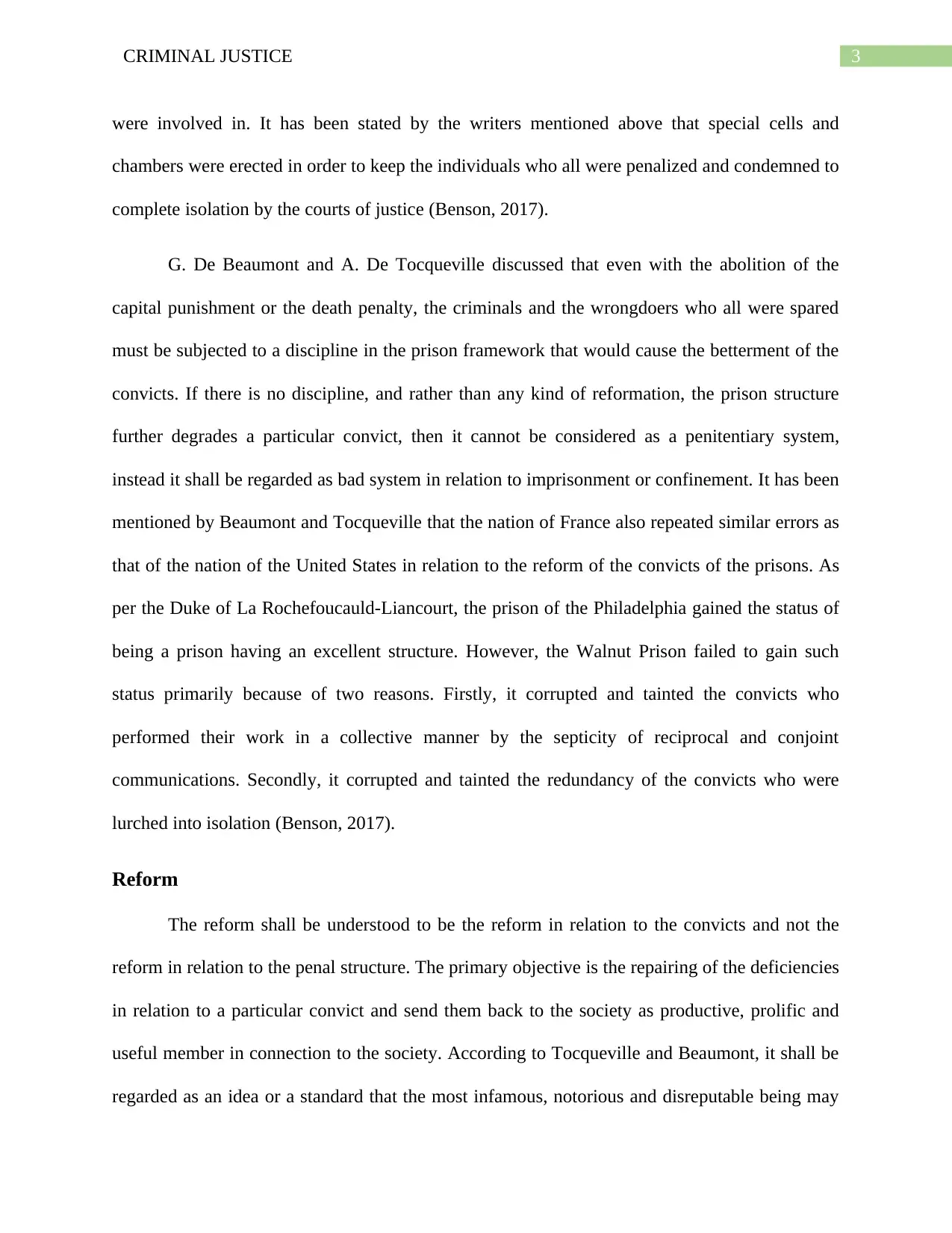
3CRIMINAL JUSTICE
were involved in. It has been stated by the writers mentioned above that special cells and
chambers were erected in order to keep the individuals who all were penalized and condemned to
complete isolation by the courts of justice (Benson, 2017).
G. De Beaumont and A. De Tocqueville discussed that even with the abolition of the
capital punishment or the death penalty, the criminals and the wrongdoers who all were spared
must be subjected to a discipline in the prison framework that would cause the betterment of the
convicts. If there is no discipline, and rather than any kind of reformation, the prison structure
further degrades a particular convict, then it cannot be considered as a penitentiary system,
instead it shall be regarded as bad system in relation to imprisonment or confinement. It has been
mentioned by Beaumont and Tocqueville that the nation of France also repeated similar errors as
that of the nation of the United States in relation to the reform of the convicts of the prisons. As
per the Duke of La Rochefoucauld-Liancourt, the prison of the Philadelphia gained the status of
being a prison having an excellent structure. However, the Walnut Prison failed to gain such
status primarily because of two reasons. Firstly, it corrupted and tainted the convicts who
performed their work in a collective manner by the septicity of reciprocal and conjoint
communications. Secondly, it corrupted and tainted the redundancy of the convicts who were
lurched into isolation (Benson, 2017).
Reform
The reform shall be understood to be the reform in relation to the convicts and not the
reform in relation to the penal structure. The primary objective is the repairing of the deficiencies
in relation to a particular convict and send them back to the society as productive, prolific and
useful member in connection to the society. According to Tocqueville and Beaumont, it shall be
regarded as an idea or a standard that the most infamous, notorious and disreputable being may
were involved in. It has been stated by the writers mentioned above that special cells and
chambers were erected in order to keep the individuals who all were penalized and condemned to
complete isolation by the courts of justice (Benson, 2017).
G. De Beaumont and A. De Tocqueville discussed that even with the abolition of the
capital punishment or the death penalty, the criminals and the wrongdoers who all were spared
must be subjected to a discipline in the prison framework that would cause the betterment of the
convicts. If there is no discipline, and rather than any kind of reformation, the prison structure
further degrades a particular convict, then it cannot be considered as a penitentiary system,
instead it shall be regarded as bad system in relation to imprisonment or confinement. It has been
mentioned by Beaumont and Tocqueville that the nation of France also repeated similar errors as
that of the nation of the United States in relation to the reform of the convicts of the prisons. As
per the Duke of La Rochefoucauld-Liancourt, the prison of the Philadelphia gained the status of
being a prison having an excellent structure. However, the Walnut Prison failed to gain such
status primarily because of two reasons. Firstly, it corrupted and tainted the convicts who
performed their work in a collective manner by the septicity of reciprocal and conjoint
communications. Secondly, it corrupted and tainted the redundancy of the convicts who were
lurched into isolation (Benson, 2017).
Reform
The reform shall be understood to be the reform in relation to the convicts and not the
reform in relation to the penal structure. The primary objective is the repairing of the deficiencies
in relation to a particular convict and send them back to the society as productive, prolific and
useful member in connection to the society. According to Tocqueville and Beaumont, it shall be
regarded as an idea or a standard that the most infamous, notorious and disreputable being may
Paraphrase This Document
Need a fresh take? Get an instant paraphrase of this document with our AI Paraphraser
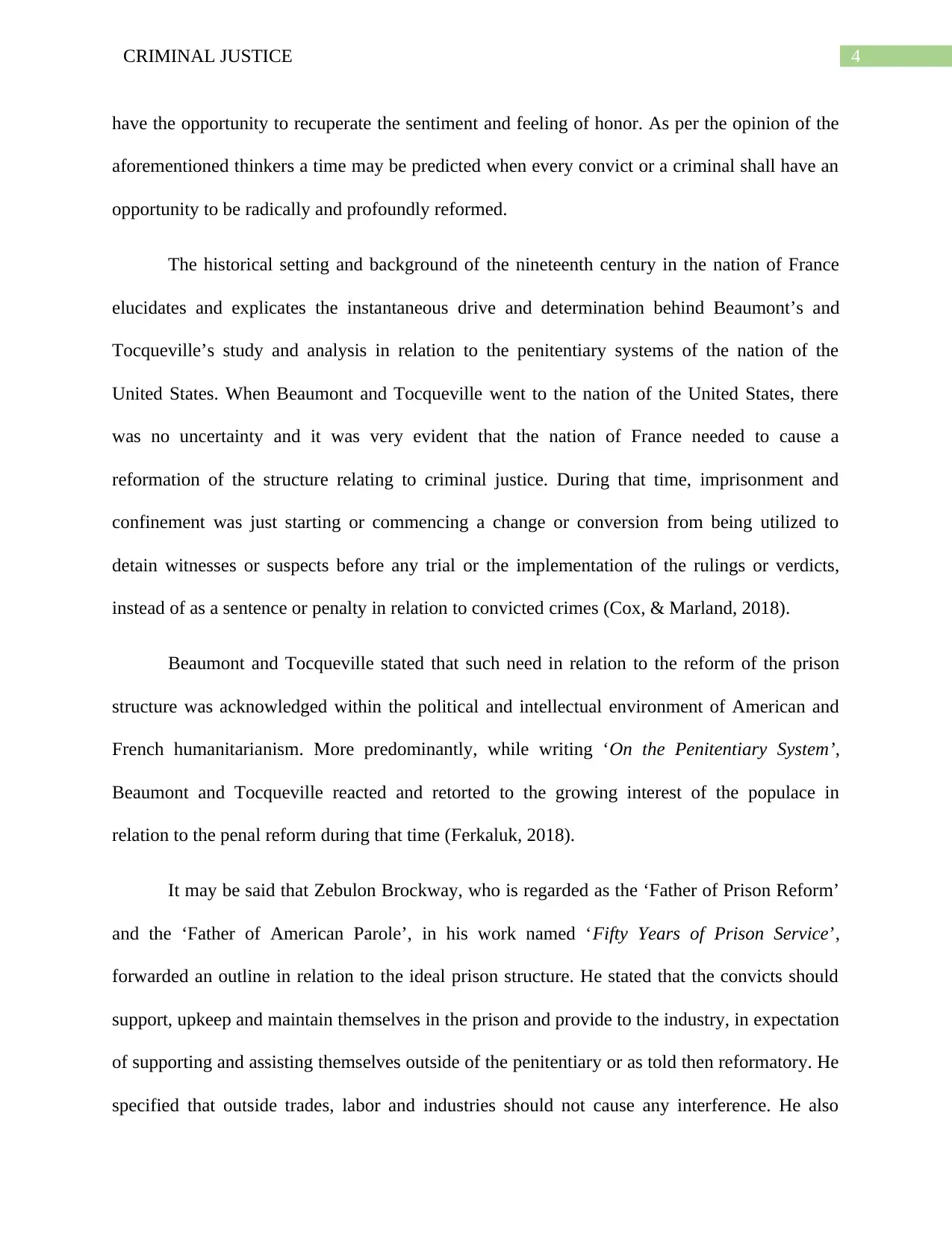
4CRIMINAL JUSTICE
have the opportunity to recuperate the sentiment and feeling of honor. As per the opinion of the
aforementioned thinkers a time may be predicted when every convict or a criminal shall have an
opportunity to be radically and profoundly reformed.
The historical setting and background of the nineteenth century in the nation of France
elucidates and explicates the instantaneous drive and determination behind Beaumont’s and
Tocqueville’s study and analysis in relation to the penitentiary systems of the nation of the
United States. When Beaumont and Tocqueville went to the nation of the United States, there
was no uncertainty and it was very evident that the nation of France needed to cause a
reformation of the structure relating to criminal justice. During that time, imprisonment and
confinement was just starting or commencing a change or conversion from being utilized to
detain witnesses or suspects before any trial or the implementation of the rulings or verdicts,
instead of as a sentence or penalty in relation to convicted crimes (Cox, & Marland, 2018).
Beaumont and Tocqueville stated that such need in relation to the reform of the prison
structure was acknowledged within the political and intellectual environment of American and
French humanitarianism. More predominantly, while writing ‘On the Penitentiary System’,
Beaumont and Tocqueville reacted and retorted to the growing interest of the populace in
relation to the penal reform during that time (Ferkaluk, 2018).
It may be said that Zebulon Brockway, who is regarded as the ‘Father of Prison Reform’
and the ‘Father of American Parole’, in his work named ‘Fifty Years of Prison Service’,
forwarded an outline in relation to the ideal prison structure. He stated that the convicts should
support, upkeep and maintain themselves in the prison and provide to the industry, in expectation
of supporting and assisting themselves outside of the penitentiary or as told then reformatory. He
specified that outside trades, labor and industries should not cause any interference. He also
have the opportunity to recuperate the sentiment and feeling of honor. As per the opinion of the
aforementioned thinkers a time may be predicted when every convict or a criminal shall have an
opportunity to be radically and profoundly reformed.
The historical setting and background of the nineteenth century in the nation of France
elucidates and explicates the instantaneous drive and determination behind Beaumont’s and
Tocqueville’s study and analysis in relation to the penitentiary systems of the nation of the
United States. When Beaumont and Tocqueville went to the nation of the United States, there
was no uncertainty and it was very evident that the nation of France needed to cause a
reformation of the structure relating to criminal justice. During that time, imprisonment and
confinement was just starting or commencing a change or conversion from being utilized to
detain witnesses or suspects before any trial or the implementation of the rulings or verdicts,
instead of as a sentence or penalty in relation to convicted crimes (Cox, & Marland, 2018).
Beaumont and Tocqueville stated that such need in relation to the reform of the prison
structure was acknowledged within the political and intellectual environment of American and
French humanitarianism. More predominantly, while writing ‘On the Penitentiary System’,
Beaumont and Tocqueville reacted and retorted to the growing interest of the populace in
relation to the penal reform during that time (Ferkaluk, 2018).
It may be said that Zebulon Brockway, who is regarded as the ‘Father of Prison Reform’
and the ‘Father of American Parole’, in his work named ‘Fifty Years of Prison Service’,
forwarded an outline in relation to the ideal prison structure. He stated that the convicts should
support, upkeep and maintain themselves in the prison and provide to the industry, in expectation
of supporting and assisting themselves outside of the penitentiary or as told then reformatory. He
specified that outside trades, labor and industries should not cause any interference. He also
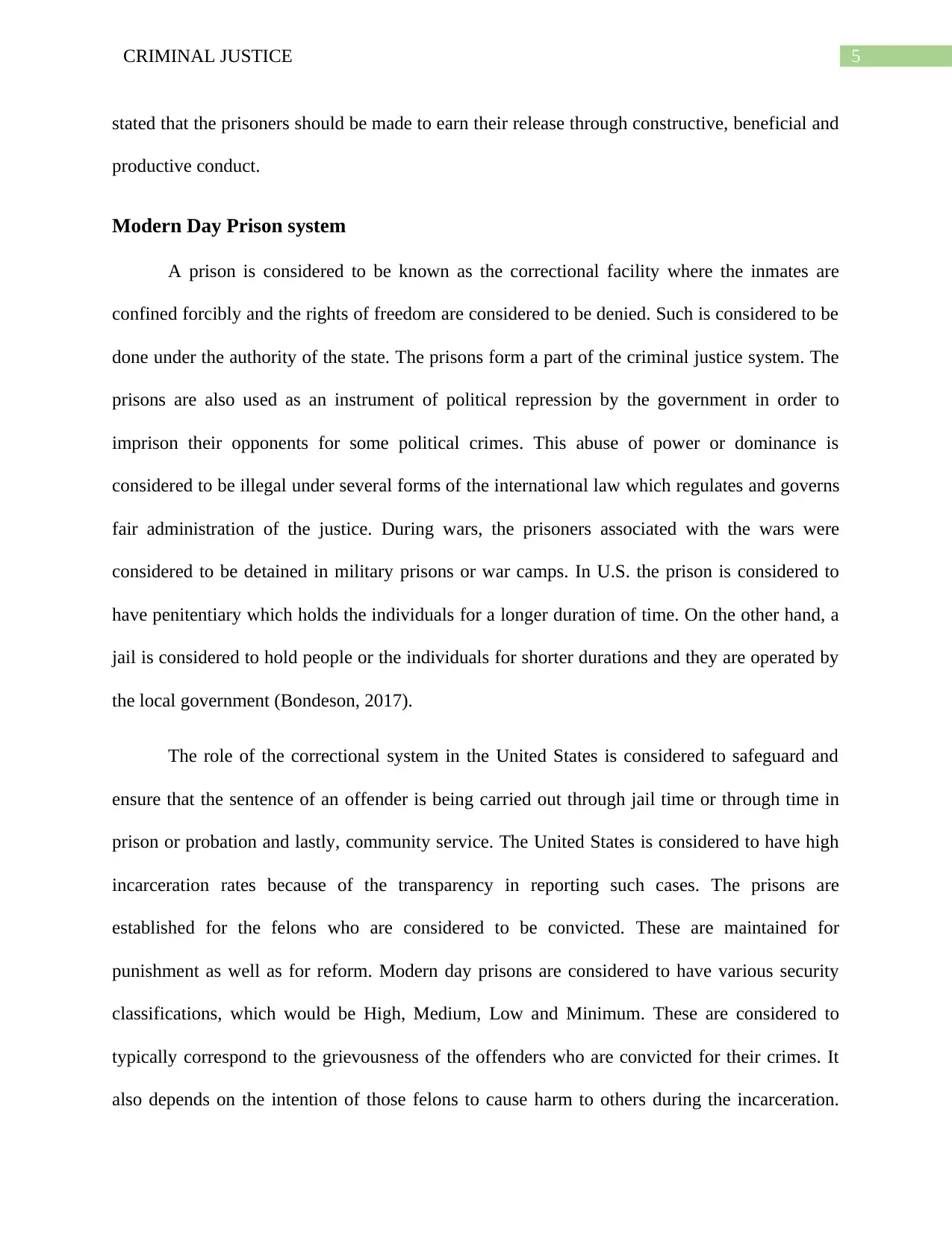
5CRIMINAL JUSTICE
stated that the prisoners should be made to earn their release through constructive, beneficial and
productive conduct.
Modern Day Prison system
A prison is considered to be known as the correctional facility where the inmates are
confined forcibly and the rights of freedom are considered to be denied. Such is considered to be
done under the authority of the state. The prisons form a part of the criminal justice system. The
prisons are also used as an instrument of political repression by the government in order to
imprison their opponents for some political crimes. This abuse of power or dominance is
considered to be illegal under several forms of the international law which regulates and governs
fair administration of the justice. During wars, the prisoners associated with the wars were
considered to be detained in military prisons or war camps. In U.S. the prison is considered to
have penitentiary which holds the individuals for a longer duration of time. On the other hand, a
jail is considered to hold people or the individuals for shorter durations and they are operated by
the local government (Bondeson, 2017).
The role of the correctional system in the United States is considered to safeguard and
ensure that the sentence of an offender is being carried out through jail time or through time in
prison or probation and lastly, community service. The United States is considered to have high
incarceration rates because of the transparency in reporting such cases. The prisons are
established for the felons who are considered to be convicted. These are maintained for
punishment as well as for reform. Modern day prisons are considered to have various security
classifications, which would be High, Medium, Low and Minimum. These are considered to
typically correspond to the grievousness of the offenders who are convicted for their crimes. It
also depends on the intention of those felons to cause harm to others during the incarceration.
stated that the prisoners should be made to earn their release through constructive, beneficial and
productive conduct.
Modern Day Prison system
A prison is considered to be known as the correctional facility where the inmates are
confined forcibly and the rights of freedom are considered to be denied. Such is considered to be
done under the authority of the state. The prisons form a part of the criminal justice system. The
prisons are also used as an instrument of political repression by the government in order to
imprison their opponents for some political crimes. This abuse of power or dominance is
considered to be illegal under several forms of the international law which regulates and governs
fair administration of the justice. During wars, the prisoners associated with the wars were
considered to be detained in military prisons or war camps. In U.S. the prison is considered to
have penitentiary which holds the individuals for a longer duration of time. On the other hand, a
jail is considered to hold people or the individuals for shorter durations and they are operated by
the local government (Bondeson, 2017).
The role of the correctional system in the United States is considered to safeguard and
ensure that the sentence of an offender is being carried out through jail time or through time in
prison or probation and lastly, community service. The United States is considered to have high
incarceration rates because of the transparency in reporting such cases. The prisons are
established for the felons who are considered to be convicted. These are maintained for
punishment as well as for reform. Modern day prisons are considered to have various security
classifications, which would be High, Medium, Low and Minimum. These are considered to
typically correspond to the grievousness of the offenders who are convicted for their crimes. It
also depends on the intention of those felons to cause harm to others during the incarceration.
⊘ This is a preview!⊘
Do you want full access?
Subscribe today to unlock all pages.

Trusted by 1+ million students worldwide
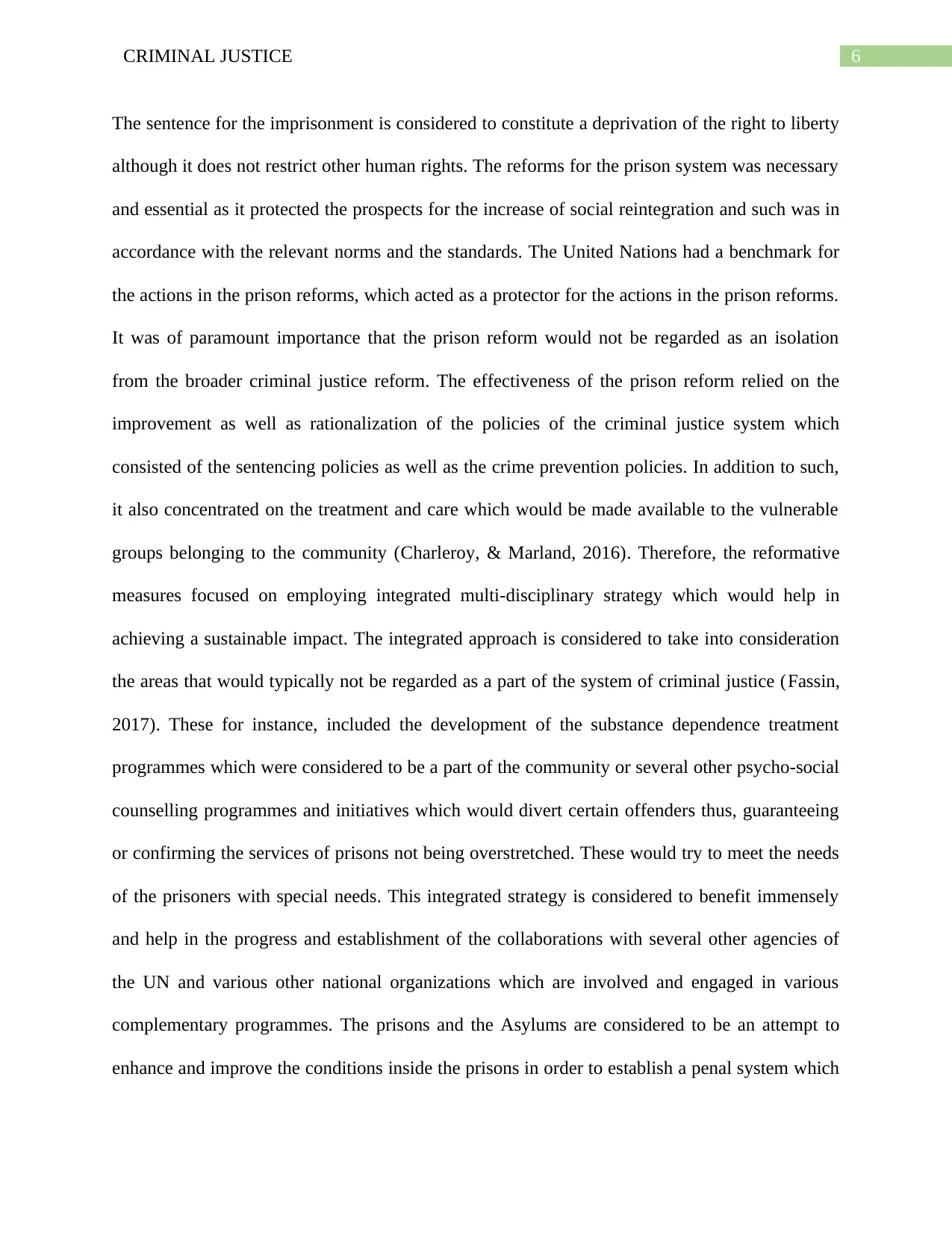
6CRIMINAL JUSTICE
The sentence for the imprisonment is considered to constitute a deprivation of the right to liberty
although it does not restrict other human rights. The reforms for the prison system was necessary
and essential as it protected the prospects for the increase of social reintegration and such was in
accordance with the relevant norms and the standards. The United Nations had a benchmark for
the actions in the prison reforms, which acted as a protector for the actions in the prison reforms.
It was of paramount importance that the prison reform would not be regarded as an isolation
from the broader criminal justice reform. The effectiveness of the prison reform relied on the
improvement as well as rationalization of the policies of the criminal justice system which
consisted of the sentencing policies as well as the crime prevention policies. In addition to such,
it also concentrated on the treatment and care which would be made available to the vulnerable
groups belonging to the community (Charleroy, & Marland, 2016). Therefore, the reformative
measures focused on employing integrated multi-disciplinary strategy which would help in
achieving a sustainable impact. The integrated approach is considered to take into consideration
the areas that would typically not be regarded as a part of the system of criminal justice (Fassin,
2017). These for instance, included the development of the substance dependence treatment
programmes which were considered to be a part of the community or several other psycho-social
counselling programmes and initiatives which would divert certain offenders thus, guaranteeing
or confirming the services of prisons not being overstretched. These would try to meet the needs
of the prisoners with special needs. This integrated strategy is considered to benefit immensely
and help in the progress and establishment of the collaborations with several other agencies of
the UN and various other national organizations which are involved and engaged in various
complementary programmes. The prisons and the Asylums are considered to be an attempt to
enhance and improve the conditions inside the prisons in order to establish a penal system which
The sentence for the imprisonment is considered to constitute a deprivation of the right to liberty
although it does not restrict other human rights. The reforms for the prison system was necessary
and essential as it protected the prospects for the increase of social reintegration and such was in
accordance with the relevant norms and the standards. The United Nations had a benchmark for
the actions in the prison reforms, which acted as a protector for the actions in the prison reforms.
It was of paramount importance that the prison reform would not be regarded as an isolation
from the broader criminal justice reform. The effectiveness of the prison reform relied on the
improvement as well as rationalization of the policies of the criminal justice system which
consisted of the sentencing policies as well as the crime prevention policies. In addition to such,
it also concentrated on the treatment and care which would be made available to the vulnerable
groups belonging to the community (Charleroy, & Marland, 2016). Therefore, the reformative
measures focused on employing integrated multi-disciplinary strategy which would help in
achieving a sustainable impact. The integrated approach is considered to take into consideration
the areas that would typically not be regarded as a part of the system of criminal justice (Fassin,
2017). These for instance, included the development of the substance dependence treatment
programmes which were considered to be a part of the community or several other psycho-social
counselling programmes and initiatives which would divert certain offenders thus, guaranteeing
or confirming the services of prisons not being overstretched. These would try to meet the needs
of the prisoners with special needs. This integrated strategy is considered to benefit immensely
and help in the progress and establishment of the collaborations with several other agencies of
the UN and various other national organizations which are involved and engaged in various
complementary programmes. The prisons and the Asylums are considered to be an attempt to
enhance and improve the conditions inside the prisons in order to establish a penal system which
Paraphrase This Document
Need a fresh take? Get an instant paraphrase of this document with our AI Paraphraser
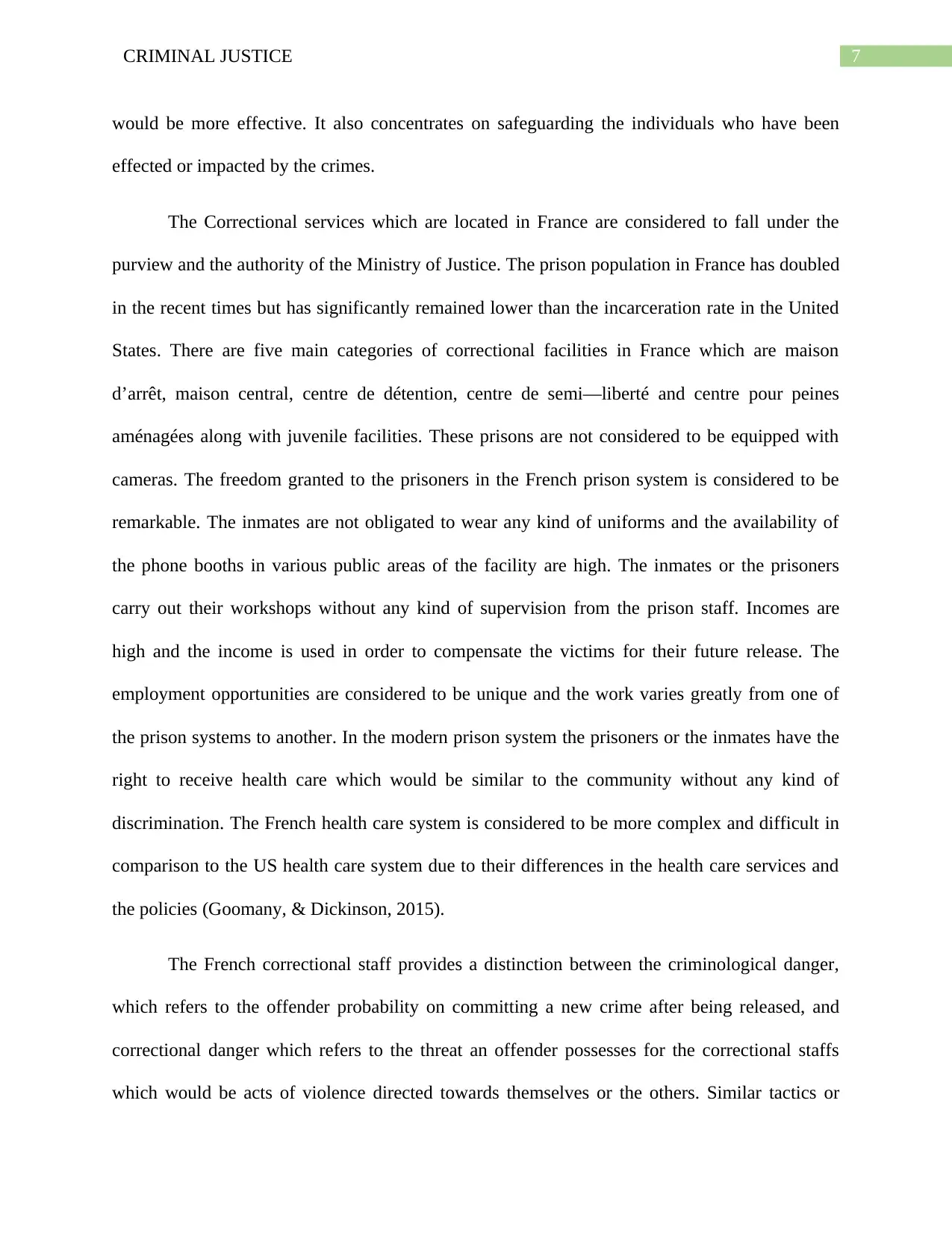
7CRIMINAL JUSTICE
would be more effective. It also concentrates on safeguarding the individuals who have been
effected or impacted by the crimes.
The Correctional services which are located in France are considered to fall under the
purview and the authority of the Ministry of Justice. The prison population in France has doubled
in the recent times but has significantly remained lower than the incarceration rate in the United
States. There are five main categories of correctional facilities in France which are maison
d’arrêt, maison central, centre de détention, centre de semi—liberté and centre pour peines
aménagées along with juvenile facilities. These prisons are not considered to be equipped with
cameras. The freedom granted to the prisoners in the French prison system is considered to be
remarkable. The inmates are not obligated to wear any kind of uniforms and the availability of
the phone booths in various public areas of the facility are high. The inmates or the prisoners
carry out their workshops without any kind of supervision from the prison staff. Incomes are
high and the income is used in order to compensate the victims for their future release. The
employment opportunities are considered to be unique and the work varies greatly from one of
the prison systems to another. In the modern prison system the prisoners or the inmates have the
right to receive health care which would be similar to the community without any kind of
discrimination. The French health care system is considered to be more complex and difficult in
comparison to the US health care system due to their differences in the health care services and
the policies (Goomany, & Dickinson, 2015).
The French correctional staff provides a distinction between the criminological danger,
which refers to the offender probability on committing a new crime after being released, and
correctional danger which refers to the threat an offender possesses for the correctional staffs
which would be acts of violence directed towards themselves or the others. Similar tactics or
would be more effective. It also concentrates on safeguarding the individuals who have been
effected or impacted by the crimes.
The Correctional services which are located in France are considered to fall under the
purview and the authority of the Ministry of Justice. The prison population in France has doubled
in the recent times but has significantly remained lower than the incarceration rate in the United
States. There are five main categories of correctional facilities in France which are maison
d’arrêt, maison central, centre de détention, centre de semi—liberté and centre pour peines
aménagées along with juvenile facilities. These prisons are not considered to be equipped with
cameras. The freedom granted to the prisoners in the French prison system is considered to be
remarkable. The inmates are not obligated to wear any kind of uniforms and the availability of
the phone booths in various public areas of the facility are high. The inmates or the prisoners
carry out their workshops without any kind of supervision from the prison staff. Incomes are
high and the income is used in order to compensate the victims for their future release. The
employment opportunities are considered to be unique and the work varies greatly from one of
the prison systems to another. In the modern prison system the prisoners or the inmates have the
right to receive health care which would be similar to the community without any kind of
discrimination. The French health care system is considered to be more complex and difficult in
comparison to the US health care system due to their differences in the health care services and
the policies (Goomany, & Dickinson, 2015).
The French correctional staff provides a distinction between the criminological danger,
which refers to the offender probability on committing a new crime after being released, and
correctional danger which refers to the threat an offender possesses for the correctional staffs
which would be acts of violence directed towards themselves or the others. Similar tactics or
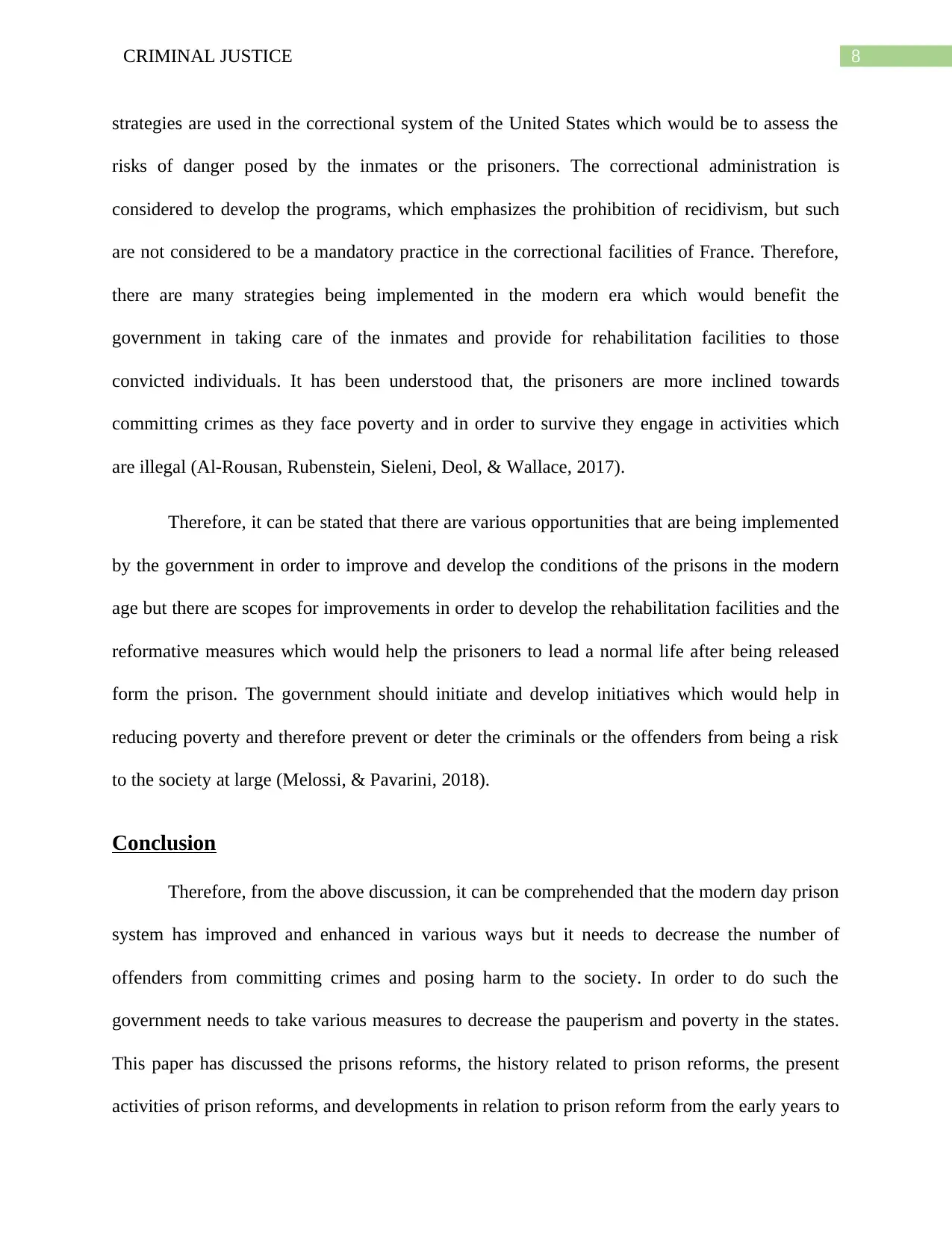
8CRIMINAL JUSTICE
strategies are used in the correctional system of the United States which would be to assess the
risks of danger posed by the inmates or the prisoners. The correctional administration is
considered to develop the programs, which emphasizes the prohibition of recidivism, but such
are not considered to be a mandatory practice in the correctional facilities of France. Therefore,
there are many strategies being implemented in the modern era which would benefit the
government in taking care of the inmates and provide for rehabilitation facilities to those
convicted individuals. It has been understood that, the prisoners are more inclined towards
committing crimes as they face poverty and in order to survive they engage in activities which
are illegal (Al-Rousan, Rubenstein, Sieleni, Deol, & Wallace, 2017).
Therefore, it can be stated that there are various opportunities that are being implemented
by the government in order to improve and develop the conditions of the prisons in the modern
age but there are scopes for improvements in order to develop the rehabilitation facilities and the
reformative measures which would help the prisoners to lead a normal life after being released
form the prison. The government should initiate and develop initiatives which would help in
reducing poverty and therefore prevent or deter the criminals or the offenders from being a risk
to the society at large (Melossi, & Pavarini, 2018).
Conclusion
Therefore, from the above discussion, it can be comprehended that the modern day prison
system has improved and enhanced in various ways but it needs to decrease the number of
offenders from committing crimes and posing harm to the society. In order to do such the
government needs to take various measures to decrease the pauperism and poverty in the states.
This paper has discussed the prisons reforms, the history related to prison reforms, the present
activities of prison reforms, and developments in relation to prison reform from the early years to
strategies are used in the correctional system of the United States which would be to assess the
risks of danger posed by the inmates or the prisoners. The correctional administration is
considered to develop the programs, which emphasizes the prohibition of recidivism, but such
are not considered to be a mandatory practice in the correctional facilities of France. Therefore,
there are many strategies being implemented in the modern era which would benefit the
government in taking care of the inmates and provide for rehabilitation facilities to those
convicted individuals. It has been understood that, the prisoners are more inclined towards
committing crimes as they face poverty and in order to survive they engage in activities which
are illegal (Al-Rousan, Rubenstein, Sieleni, Deol, & Wallace, 2017).
Therefore, it can be stated that there are various opportunities that are being implemented
by the government in order to improve and develop the conditions of the prisons in the modern
age but there are scopes for improvements in order to develop the rehabilitation facilities and the
reformative measures which would help the prisoners to lead a normal life after being released
form the prison. The government should initiate and develop initiatives which would help in
reducing poverty and therefore prevent or deter the criminals or the offenders from being a risk
to the society at large (Melossi, & Pavarini, 2018).
Conclusion
Therefore, from the above discussion, it can be comprehended that the modern day prison
system has improved and enhanced in various ways but it needs to decrease the number of
offenders from committing crimes and posing harm to the society. In order to do such the
government needs to take various measures to decrease the pauperism and poverty in the states.
This paper has discussed the prisons reforms, the history related to prison reforms, the present
activities of prison reforms, and developments in relation to prison reform from the early years to
⊘ This is a preview!⊘
Do you want full access?
Subscribe today to unlock all pages.

Trusted by 1+ million students worldwide

9CRIMINAL JUSTICE
the present days. Thus this paper has also discussed the writings of Alexis De Tocqueville and
Gustave De Beaumont in relation to the penitentiary structure of the nation of the United States
and the application of such in relation to the nation of France.
the present days. Thus this paper has also discussed the writings of Alexis De Tocqueville and
Gustave De Beaumont in relation to the penitentiary structure of the nation of the United States
and the application of such in relation to the nation of France.
Paraphrase This Document
Need a fresh take? Get an instant paraphrase of this document with our AI Paraphraser
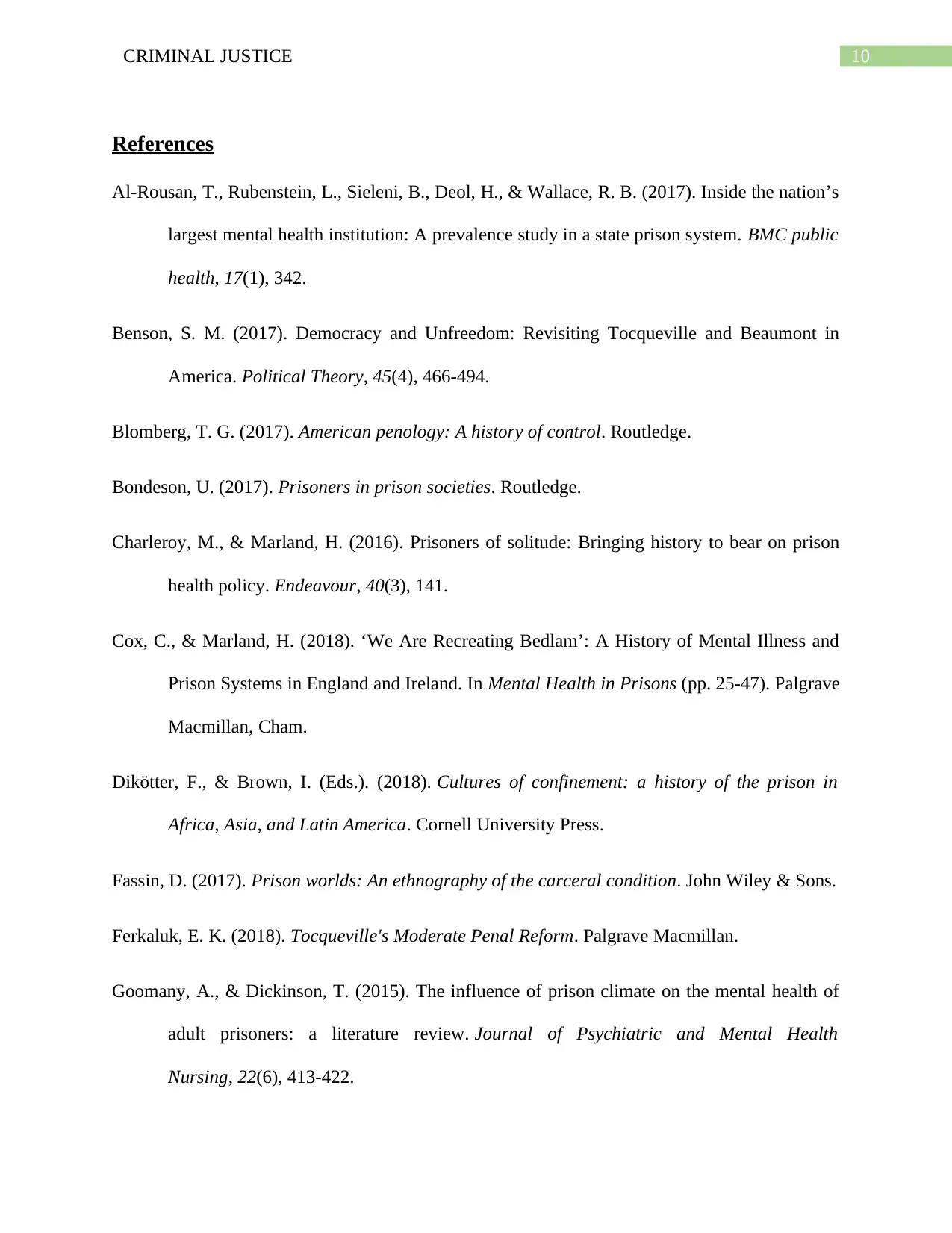
10CRIMINAL JUSTICE
References
Al-Rousan, T., Rubenstein, L., Sieleni, B., Deol, H., & Wallace, R. B. (2017). Inside the nation’s
largest mental health institution: A prevalence study in a state prison system. BMC public
health, 17(1), 342.
Benson, S. M. (2017). Democracy and Unfreedom: Revisiting Tocqueville and Beaumont in
America. Political Theory, 45(4), 466-494.
Blomberg, T. G. (2017). American penology: A history of control. Routledge.
Bondeson, U. (2017). Prisoners in prison societies. Routledge.
Charleroy, M., & Marland, H. (2016). Prisoners of solitude: Bringing history to bear on prison
health policy. Endeavour, 40(3), 141.
Cox, C., & Marland, H. (2018). ‘We Are Recreating Bedlam’: A History of Mental Illness and
Prison Systems in England and Ireland. In Mental Health in Prisons (pp. 25-47). Palgrave
Macmillan, Cham.
Dikötter, F., & Brown, I. (Eds.). (2018). Cultures of confinement: a history of the prison in
Africa, Asia, and Latin America. Cornell University Press.
Fassin, D. (2017). Prison worlds: An ethnography of the carceral condition. John Wiley & Sons.
Ferkaluk, E. K. (2018). Tocqueville's Moderate Penal Reform. Palgrave Macmillan.
Goomany, A., & Dickinson, T. (2015). The influence of prison climate on the mental health of
adult prisoners: a literature review. Journal of Psychiatric and Mental Health
Nursing, 22(6), 413-422.
References
Al-Rousan, T., Rubenstein, L., Sieleni, B., Deol, H., & Wallace, R. B. (2017). Inside the nation’s
largest mental health institution: A prevalence study in a state prison system. BMC public
health, 17(1), 342.
Benson, S. M. (2017). Democracy and Unfreedom: Revisiting Tocqueville and Beaumont in
America. Political Theory, 45(4), 466-494.
Blomberg, T. G. (2017). American penology: A history of control. Routledge.
Bondeson, U. (2017). Prisoners in prison societies. Routledge.
Charleroy, M., & Marland, H. (2016). Prisoners of solitude: Bringing history to bear on prison
health policy. Endeavour, 40(3), 141.
Cox, C., & Marland, H. (2018). ‘We Are Recreating Bedlam’: A History of Mental Illness and
Prison Systems in England and Ireland. In Mental Health in Prisons (pp. 25-47). Palgrave
Macmillan, Cham.
Dikötter, F., & Brown, I. (Eds.). (2018). Cultures of confinement: a history of the prison in
Africa, Asia, and Latin America. Cornell University Press.
Fassin, D. (2017). Prison worlds: An ethnography of the carceral condition. John Wiley & Sons.
Ferkaluk, E. K. (2018). Tocqueville's Moderate Penal Reform. Palgrave Macmillan.
Goomany, A., & Dickinson, T. (2015). The influence of prison climate on the mental health of
adult prisoners: a literature review. Journal of Psychiatric and Mental Health
Nursing, 22(6), 413-422.
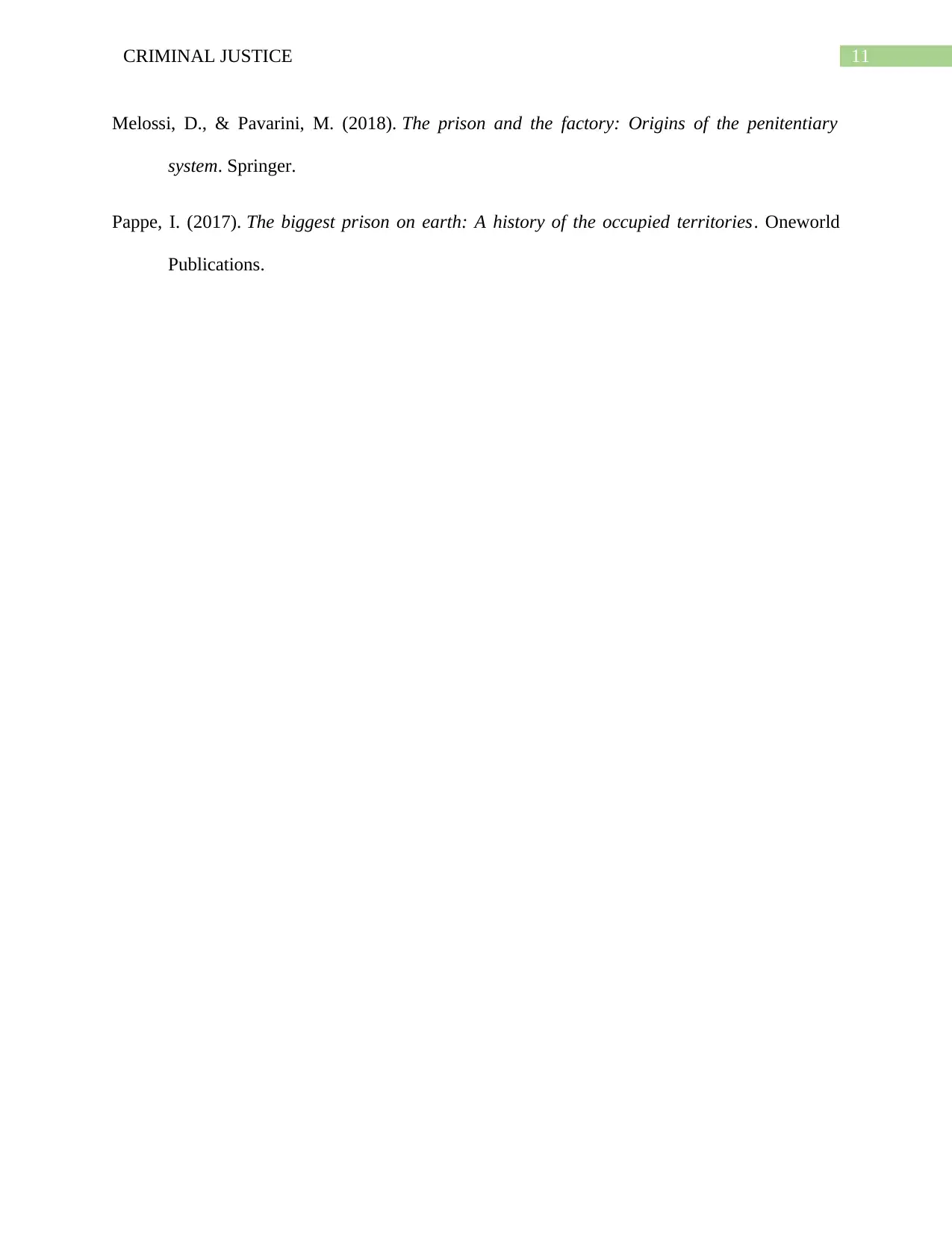
11CRIMINAL JUSTICE
Melossi, D., & Pavarini, M. (2018). The prison and the factory: Origins of the penitentiary
system. Springer.
Pappe, I. (2017). The biggest prison on earth: A history of the occupied territories. Oneworld
Publications.
Melossi, D., & Pavarini, M. (2018). The prison and the factory: Origins of the penitentiary
system. Springer.
Pappe, I. (2017). The biggest prison on earth: A history of the occupied territories. Oneworld
Publications.
⊘ This is a preview!⊘
Do you want full access?
Subscribe today to unlock all pages.

Trusted by 1+ million students worldwide
1 out of 12
Your All-in-One AI-Powered Toolkit for Academic Success.
+13062052269
info@desklib.com
Available 24*7 on WhatsApp / Email
![[object Object]](/_next/static/media/star-bottom.7253800d.svg)
Unlock your academic potential
Copyright © 2020–2025 A2Z Services. All Rights Reserved. Developed and managed by ZUCOL.

